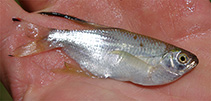Pseudocorynopoma stanleyi Malabarba, Chuctaya, Hirschmann, Oliveira & Thomaz, 2020
Clear-finned dragonfin tetra
Carregue seu(sua) Fotos e vídeos
Pictures | Imagem do GooglePseudocorynopoma stanleyi
Picture by Petersen, P.
Pictures | Imagem do GooglePseudocorynopoma stanleyi
Picture by Petersen, P.
Common names from other countries
Classificação / Names Nomes comuns | Sinônimos | Catalog of Fishes(Gênero, Espécies) | ITIS | CoL | WoRMS | Cloffa
> Characiformes (Characins) > Characidae (Characins; tetras) > Stevardiinae
Etymology: Pseudocorynopoma: Greek, pseudes = false + Greek, koryne = stick + Greek, poma = cover, operculum (Ref. 45335).
Eponymy: Professor Dr Stanley Howard Weitzman (1927–2017) was honoured for his great contribution to our knowledge of Neotropical freshwater fish (see Weitzman, SH). (Ref. 128868), visit book page.
Etymology: Pseudocorynopoma: Greek, pseudes = false + Greek, koryne = stick + Greek, poma = cover, operculum (Ref. 45335).
Eponymy: Professor Dr Stanley Howard Weitzman (1927–2017) was honoured for his great contribution to our knowledge of Neotropical freshwater fish (see Weitzman, SH). (Ref. 128868), visit book page.
Environment: milieu / climate zone / depth range / distribution range Ecologia
; Água doce bentopelágico. Tropical
Distribuição Países | Áreas da FAO | Ecossistemas | Ocorrências | Point map | Introduções | Faunafri
South America: Brazil and Uruguay.
Tamanho / Peso / Idade
Maturity: Lm ? range ? - ? cm
Max length : 6.2 cm SL macho/indeterminado; (Ref. 123882); 6.1 cm SL (female)
Max length : 6.2 cm SL macho/indeterminado; (Ref. 123882); 6.1 cm SL (female)
Descrição suscinta Chaves de identificação | Morfologia | Morfometria
Raios dorsais (total) : 9; Raios anais : 32 - 37; Vértebras: 37 - 39. This species is distinguished from P. heterandria by the number of branched anal-fin rays 32-36 (vs. 35-40 in P. heterandria); presence in males of an intermediate lobe in the distal margin of the anal fin (vs. absence); presence of hooks on the anal-fin rays of the intermediate lobe only (vs. presence of hooks in the branched anal-fin rays of the anterior lobe); presence of marks coloured in pink, black and white at the tips of the caudal-fin lobes in both sexes (vs. absent). It differs from P. doriae in both sexes by the arrangement of the white, red and black marks at the tip of the dorsal lobe of the caudal fin and in mature males by the absence of black spots at the distal tip of the pectoral fin and by the absence of black spots in the distal tip of the rays of the anterior lobe of the anal fin (vs. present in P. doriae); differs further by the growth patterns of the caudal peduncle length in females and of the anal-fin base length in males and by 87 mutational steps in mtDNA sequences (COI and ND2) (Ref. 123882).
Ciclo de vida ou comportamento de acasalamento Maturidade | Reprodução | Desova | Ovos | Fecundidade | Larvas
Referência principal
Upload your references | Referências | Coordenador | Colaboradores
Malabarba, L.R., J. Chuctaya, A. Hirschmann, E.B. de Oliveira and A.T. Thomaz, 2020. Hidden or unnoticed? Multiple lines of evidence support the recognition of a new species of Pseudocorynopoma (Characidae: Corynopomini). J. Fsh. Biol. 98(1):219-236. (Ref. 123882)
Ameaça para os humanos
Harmless
Uso pelos humanos
FAO(Publication : search) | FishSource |
Mais informação
Trophic ecology
Itens alimentares
Composição da dieta
Consumo alimentar
Food rations
Predadores
Itens alimentares
Composição da dieta
Consumo alimentar
Food rations
Predadores
Ecology
Ecologia
Home ranges
Ecologia
Home ranges
Population dynamics
Parâmetros de crescimento
Max. ages / sizes
Length-weight rel.
Length-length rel.
Frequências de comprimento
Conversão de massa
Recrutamento
Abundância
Parâmetros de crescimento
Max. ages / sizes
Length-weight rel.
Length-length rel.
Frequências de comprimento
Conversão de massa
Recrutamento
Abundância
Life cycle
Reprodução
Maturidade
Fecundidade
Desova
Spawning aggregations
Ovos
Desenvolvimento dos ovos
Larvas
Dinâmica larval
Reprodução
Maturidade
Fecundidade
Desova
Spawning aggregations
Ovos
Desenvolvimento dos ovos
Larvas
Dinâmica larval
Anatomy
Área branquial
Brain
Otolith
Área branquial
Brain
Otolith
Physiology
Body composition
Nutrients
Consumo de oxigênio
Tipo de natação
Velocidade de natação
Visual pigments
Fish sound
Diseases & Parasites
Toxicity (LC50s)
Body composition
Nutrients
Consumo de oxigênio
Tipo de natação
Velocidade de natação
Visual pigments
Fish sound
Diseases & Parasites
Toxicity (LC50s)
Genetics
Genética
Heterozygosity
Hereditariedade
Genética
Heterozygosity
Hereditariedade
Human related
Aquaculture systems
Perfis para aquacultura
Estirpes
Ciguatera cases
Stamps, coins, misc.
Aquaculture systems
Perfis para aquacultura
Estirpes
Ciguatera cases
Stamps, coins, misc.
Ferramentas
Livro eletrônico | Guia de campo | Ferramenta auxiliar de frequências de comprimento | Ferramenta sobre a história de vida | Mapa de pontos | Classification Tree
| Catch-MSY |
Relatórios especiais
Checar Manutenção em Aquário | Checar Planilhas de Fatos sobre as Espécies | Checar Planilhas de Fatos sobre Aquicultura
Baixar XML
Fontes da internet
Aquatic Commons | BHL | Cloffa | Websites from users | Checar Observador de Peixes (FishWatcher) | CISTI | Catalog of Fishes(Gênero, Espécies) | DiscoverLife | ECOTOX | Faunafri | Fishtrace | GenBank(genoma, nucleotídeo) | GloBI | GOBASE | | Google Books | Google Scholar | Google | IGFA World Record | MitoFish | Bases de dados nacionais | Otolith Atlas of Taiwan Fishes | PubMed | Reef Life Survey | Scirus | SeaLifeBase | Árvore da vida | Wikipedia(Ir para, procura) | World Records Freshwater Fishing | Zoobank | Registro zoológico
Estimates based on models
Índice de diversidade filogenética (Ref. 82804): PD50 = No PD50 data [Uniqueness, from 0.5 = low to 2.0 = high].
Bayesian length-weight: a=0.01585 (0.00672 - 0.03736), b=3.00 (2.80 - 3.20), in cm Total Length, based on LWR estimates for this (Sub)family-body shape (Ref. 93245).
Nível Trófico (Ref. 69278): 3.0 ±0.4 se; based on size and trophs of closest relatives
Resiliência (Ref. 120179): Elevada, tempo mínimo de duplicação da população menor que 15 meses (Preliminary K or Fecundity.).
Fishing Vulnerability (Ref. 59153): Low vulnerability (10 of 100).




